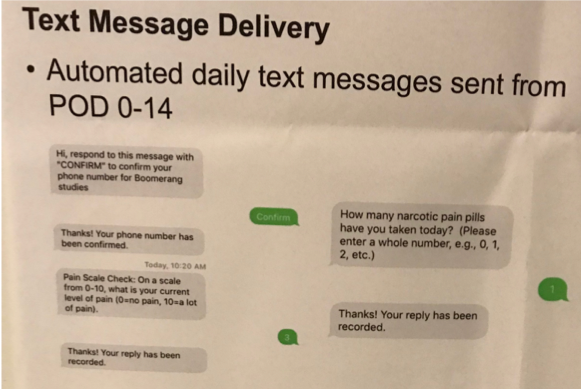Ureteroscopy with laser lithotripsy (ULL) is often an ambulatory procedure, which can make an accurate assessment of postoperative pain and subsequent opioid use difficult to achieve. With the use of an automated post-ULL text messaging system (figure 1), the investigators were able to collect real-time data regarding patient pain scores and prescribed opioid use through postoperative day 14.

Figure 1. An example of the automated post-ULL text messaging system.
In the cohort of 46 patients, the median time to resolution of postoperative pain was 7 days, while the median postoperative opioid consumption was 10 total pills (figure 2). Furthermore, these data allowed the investigators to use multivariate analysis in order to identify predictive factors for increased time to postoperative pain resolution and opioid consumption. Factors predictive of both increased time to pain resolution and increased postoperative opioid consumption were a higher pain at the time of surgery and opioid use at the time of surgery. Decreased time to pain resolution and decreased opioid consumption were predicted by preoperative renal drainage (nephrostomy tube or ureteral stent).

Figure 2. Median postoperative time to pain resolution (top) and median postoperative opioid pill consumption (bottom).
In light of these data, Dr. Flynn and his colleagues at the University of Iowa have decreased the number of opioid pills they prescribe from 30 to 15, as 63% of all prescribed pills went unused prior to this change. Additionally, these predictive factors may have the advantage of guiding patient-specific pain management following ULL, such as increasing the incorporation of NSAIDS. Interestingly, an audience member was surprised by the fact that opioids are automatically prescribed for post-ULL pain control in the United States, as this practice is not done in Europe.
Presented by: Kevin Flynn, MD, Urology Resident, University of Iowa Department of Urology, Iowa City, Iowa
Co-Authors: Associate Professor Chad Tracy, Associate Professor Bradley Erickson, Resident Physician Paul Guidos, Associate Professor of Internal Medicine, Infectious Diseases Associate Professor of Epidemiology Philip Polgreen
Author Affiliation: The University of Iowa, Department of Urology


